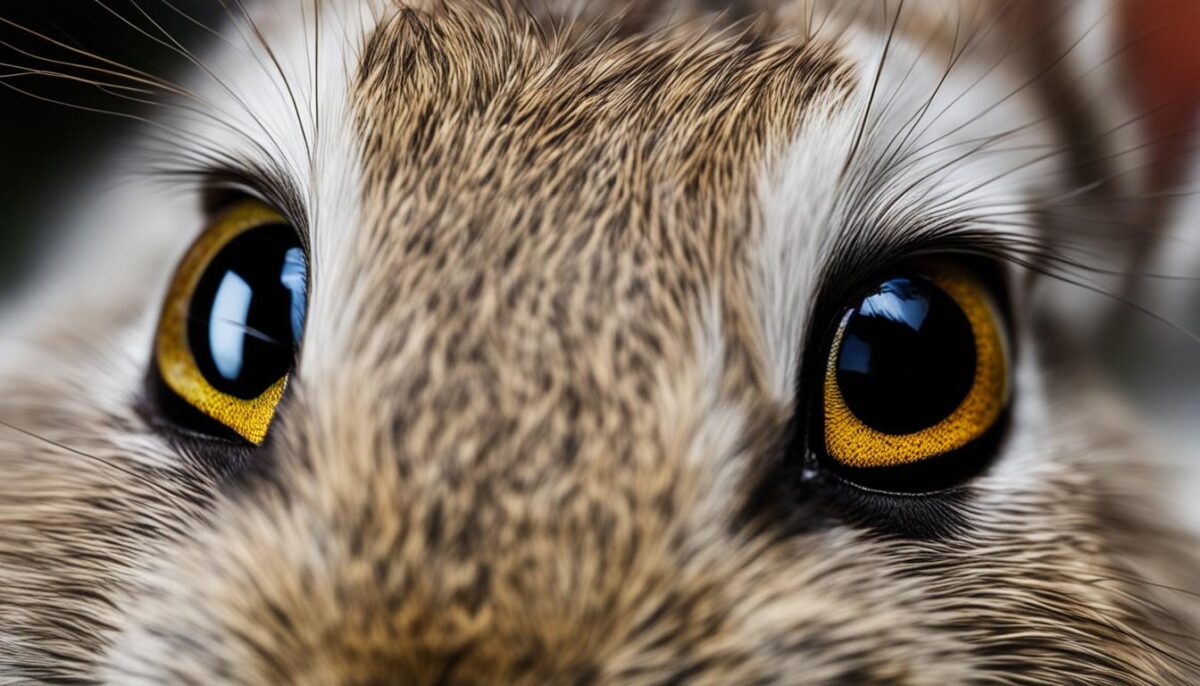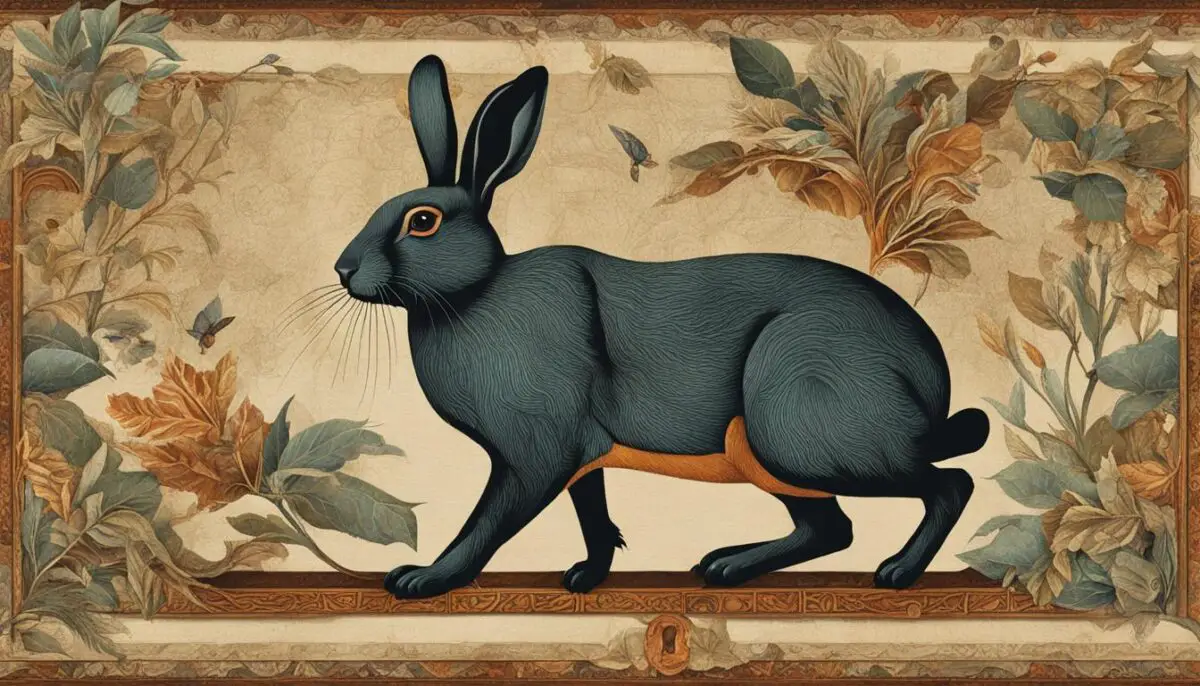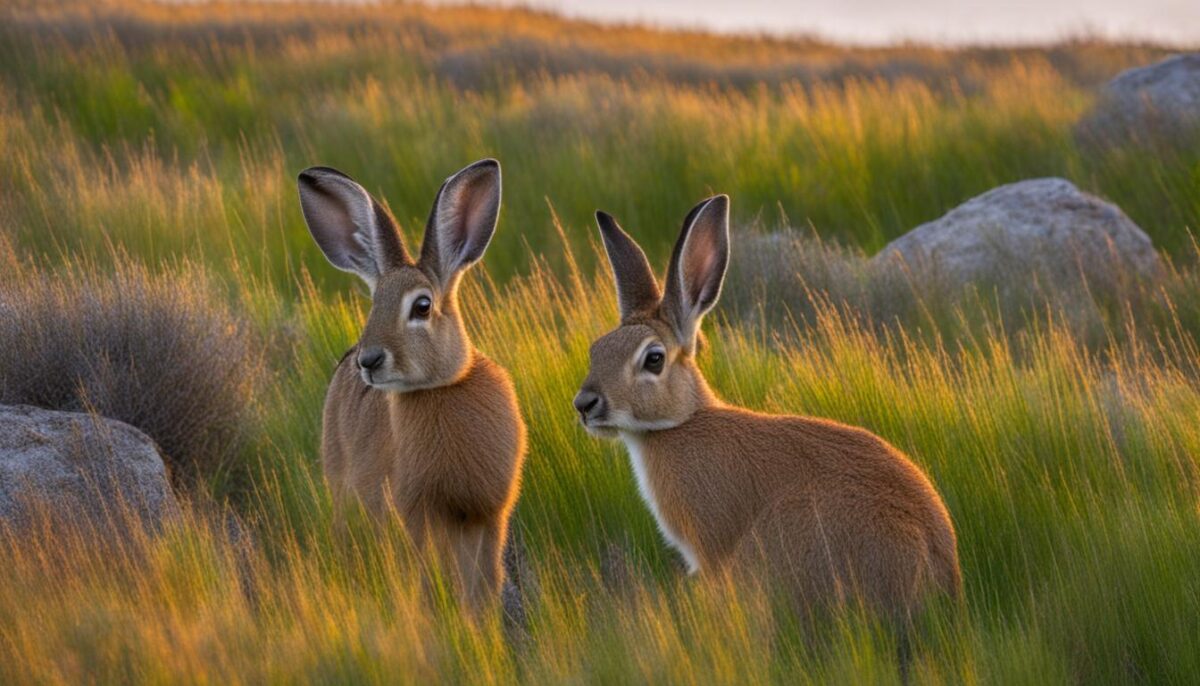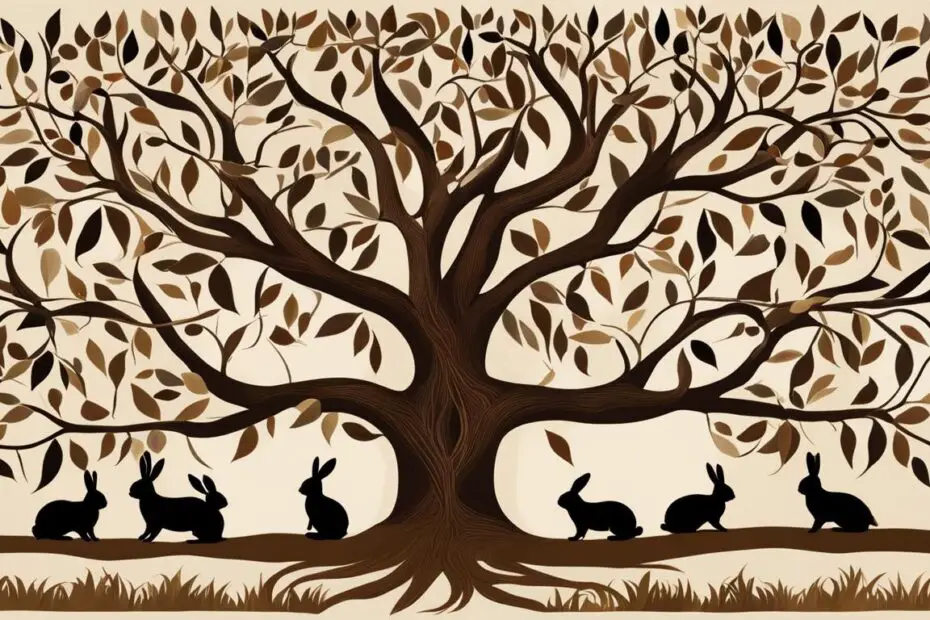Did you know that rabbits, often thought to be close relatives of rodents, are actually more closely related to primates? A recent study published in the journal Nature has revealed fascinating insights into the genetic connections and ancestry of rabbits.
The researchers compared the structures of proteins common to all mammals and found that rabbits share more anatomical features with primates than with rodents. This suggests that rabbits and primates share a common ancestor, with some anatomical traits being lost in certain lineages over time.
Key Takeaways:
- Rabbits, once classified as close relatives of rodents, are actually more closely related to primates.
- A study comparing the structures of proteins in mammals revealed genetic similarities between rabbits and primates.
- Rabbits and primates share a common ancestor, with some anatomical traits being lost over time.
- The genetic connections and ancestry of rabbits provide fascinating insights into their evolutionary history.
- Rabbits have unique anatomical features that differentiate them from rodents, including four incisors in their upper jaw and long hind legs for leaping.
Who are Rabbits Related to
The Classification of Rabbits: Lagomorpha and Glires
Rabbits and hares, once thought to be closely related to rodents, belong to the order Lagomorpha. This order also includes pikas, small mammals known for their distinctive appearance and habitat in mountainous regions. However, a recent study has challenged the traditional classification of lagomorphs within a superorder called Glires, which also includes rodents. The study found that lagomorphs, including rabbits, share more genetic similarities with primates than with rodents, suggesting a closer evolutionary connection to primates. who are rabbits related to
This reclassification highlights the complex relationships between different groups of animals and underscores the need for continuous research and reevaluation of taxonomic classifications. It also sheds light on the unique characteristics of rabbits and their evolutionary history. While lagomorphs and rodents may share certain traits, such as continuously growing incisors and similar skeletal structures, the genetic evidence points to a closer relationship between lagomorphs and primates.rabbit family tree
To better understand the classification of lagomorphs, it is important to consider the anatomical and behavioral differences that set them apart from rodents. Lagomorphs, including rabbits, have four incisors in their upper jaw, while rodents have only two. Additionally, rabbits possess long hind legs, allowing for their distinctive leaping form of locomotion, while rodents have shorter limbs suited for scurrying on the ground. These anatomical differences, along with the genetic evidence, support the reclassification of lagomorphs as a separate order within the animal kingdom.
| Characteristics | Lagomorphs (Rabbits) | Rodents |
|---|---|---|
| Number of Upper Incisors | 4 | 2 |
| Hind Leg Length | Long, adapted for leaping | Shorter, adapted for scurrying |
“The genetic evidence points to a closer relationship between lagomorphs and primates.”
In conclusion, the classification of rabbits as lagomorphs challenges the previous categorization within the superorder Glires. Genetic evidence has revealed a closer relationship between lagomorphs and primates, highlighting their unique place within the animal kingdom. Understanding the classification and evolutionary connections of rabbits provides valuable insights into the intricate web of life on Earth and reminds us of the ever-evolving nature of scientific knowledge.
The Anatomy of Rabbits: Unique Features and Adaptations
Rabbits have distinct anatomical features that differentiate them from rodents. These adaptations have allowed them to thrive in their environments and evade predators. Let’s explore some of the unique characteristics that make rabbits fascinating creatures.rabbit evolution
Four Incisors and Leaping Locomotion
Unlike rodents, which have two incisors in their upper jaw, rabbits have four. This additional set of incisors helps them efficiently chew and process their plant-based diet. Additionally, rabbits possess long hind legs, which enable their leaping form of locomotion. Their hind limbs are longer than their forelimbs, contributing to their speed and agility.
Fur-Covered Paws and No Paw Pads
Another interesting adaptation is that rabbits have no paw pads. Their paws are entirely covered in fur, which not only provides them with warmth and protection but also helps them move silently. This stealthy approach allows them to navigate their surroundings without alerting potential predators.rabbit biology
Anatomical Adaptations for Survival
Rabbits also have well-developed musculature, particularly in their hind limbs. This muscular strength and agility allow them to swiftly change direction and evade predators. Their outstanding ability to reproduce quickly is another notable adaptation that ensures the survival of their species. rabbit ancestors
| Unique Features of Rabbits | Adaptations |
|---|---|
| Four incisors in the upper jaw | Efficient chewing and processing of plant-based diet |
| Long hind legs | Leaping form of locomotion, speed, and agility |
| Fur-covered paws | Stealthy movement and protection |
| Anatomy without paw pads | Movement without alerting predators |
| Well-developed musculature | Speed, agility, and evasive maneuvers |
These unique anatomical adaptations of rabbits showcase their remarkable ability to thrive in various environments and contribute to their overall success as a species.

The Diversity of Rabbit Species: From European Rabbits to Cottontails
Rabbits are a diverse group of species that exhibit a wide range of characteristics and adaptations. From the well-known European rabbit to the various types of cottontail, rabbits have evolved to thrive in different habitats and environments.
Let’s take a closer look at some of the notable rabbit species:
- European Rabbit (Oryctolagus cuniculus) – The European rabbit is perhaps the most familiar species, found on every continent except Antarctica. It has been introduced to various regions for both hunting and domestication purposes. Known for their burrowing habits, European rabbits are adaptable and can be found in a wide range of habitats.rabbit relatives
- Cottontail Rabbits (Genus Sylvilagus) – Cottontails are a group of rabbits native to the Americas. There are various species of cottontails, including the Eastern cottontail, Desert cottontail, and Marsh rabbit. They are characterized by their cotton-like tail and are known for their ability to blend into their surroundings.
Rabbits are a testament to the diverse possibilities of evolution. From the burrows of the European rabbit to the agile nature of cottontails, each species has adapted to its specific environment in remarkable ways.
Understanding the diversity of rabbit species allows us to appreciate the intricate web of life on our planet. These fascinating creatures remind us of the incredible variety of life forms that coexist with us.
The Evolutionary History of Rabbits: An Ancient Lineage
Through the examination of fossil evidence and scientific research, the evolutionary history of rabbits is slowly being pieced together. Recent findings suggest that lagomorphs, the order to which rabbits belong, may have descended from a group called Anagaloidea, also known as “mimotonids”, rather than directly from the ancestor Eurymylus. This challenges previous assumptions about their origin and sheds light on the ancient lineage of these fascinating creatures.
The earliest leporids, the family that includes rabbits, appeared in the late Eocene period, around 35 million years ago. Their rapid spread throughout the Northern Hemisphere indicates their adaptability and successful colonization of various environments. These early rabbits showed a trend towards longer hind limbs, a characteristic that facilitated their unique leaping form of locomotion.rabbit classification
While the exact evolutionary path of rabbits is still not fully understood, their ancient lineage is evident in their distinct anatomical features and adaptations. The longer hind limbs and well-developed musculature of rabbits allowed them to thrive in their environments and evade predators. These physical attributes, combined with their genetic connections to primates, highlight the resilience and evolutionary success of rabbits throughout history. rabbit lineage
| Period | Key Events |
|---|---|
| Late Eocene | First appearance of leporids, including rabbits |
| 35 million years ago | Rapid spread of rabbits throughout the Northern Hemisphere |
| Ongoing | Evidence of genetic connections between rabbits and primates |
“The evolutionary history of rabbits is a complex tapestry that we are only beginning to unravel. Their unique adaptations, such as their leaping locomotion and genetic connections to primates, provide clues to their ancient lineage and evolutionary success.”
Further research and analysis of genetic and fossil records will undoubtedly continue to deepen our understanding of the evolutionary history of rabbits. Uncovering their ancient roots not only expands our knowledge of animal evolution but also highlights the intricate and interconnected nature of the natural world. rabbit genetic connections
Rabbit Terminology and Etymology: From “Bunny” to “Cony”
Rabbits are known by different names in popular culture, reflecting their diverse linguistic history and cultural significance. The term commonly used to refer to these adorable creatures is “bunny”. This informal term is often associated with cute and cuddly rabbits, especially when used to describe baby rabbits. Another term that is less commonly used today is “cony”, which was historically used to refer to adult rabbits. The word “cony” can be traced back to Middle English and has its roots in the Walloon word “robète”, which means “hare”.
The history of the term “rabbit” is equally fascinating. Derived from the Middle English word “rabet”, it became a widely used term to describe these furry creatures. Interestingly, the Middle English word itself borrowed from the Walloon word “robète”, which also means “hare”. This highlights the close connection between rabbits and hares in terms of their etymology. The usage of different terms reflects the rich linguistic heritage surrounding these beloved animals.
“A rose by any other name would smell as sweet.” – William Shakespeare
These various terms and their historical origins demonstrate the enduring fascination that humans have had with rabbits throughout history. Whether it’s the endearing term “bunny”, the older term “cony”, or the more general term “rabbit”, these names reflect the deep cultural significance of these animals in human society.
| Term | Meaning |
|---|---|
| Bunny | An informal term used to refer to rabbits, often associated with their cute and cuddly nature. |
| Cony | An older term used to refer to adult rabbits, derived from Middle English and with roots in the Walloon word for “hare”. |
| Kit | A term used to refer to young rabbits. |
| Rabbit | A widely used term derived from Middle English, borrowed from the Walloon word for “hare”. |
The diverse terminology surrounding rabbits reflects the widespread appreciation and fascination that people have for these remarkable creatures. From their cute and cuddly image to their historical significance, rabbits continue to capture our attention and hearts.

The Domestication and Breeding of Rabbits: From Livestock to Pets
Rabbits have a long history of domestication, dating back to the Middle Ages. They have been selectively bred to develop various breeds with distinct characteristics, serving different purposes in human societies. The domestication of rabbits has led to their use as livestock, fur suppliers, and beloved pets.
One of the well-known breeds resulting from selective breeding is the Angora rabbit. These rabbits are prized for their long, silky fur, which is harvested for the production of luxurious Angora wool. Other breeds, such as the Flemish Giant, are bred for their large size, making them suitable for meat production. The Dutch rabbit breed, with its distinct color pattern and compact size, is a popular pet choice.
In addition to these specific breeds, countless other breeds and variations exist, each with its own unique characteristics and purpose. Breeding rabbits with desired traits has allowed for the development of breeds that fulfill specific needs and preferences. This includes coat color, fur length, body shape, and temperament.
| Breed | Characteristics | Purpose |
|---|---|---|
| Angora | Long, silky fur | Fiber production |
| Flemish Giant | Large size | Meat production |
| Dutch | Distinct color pattern, compact size | Pet |
Table: Examples of Different Rabbit Breeds and Their Characteristics
“Through selective breeding, humans have shaped the characteristics of different rabbit breeds to meet their diverse needs. This practice has allowed us to create rabbits optimized for various purposes, whether it be for their fur, meat, or companionship. The domestication and breeding of rabbits have played an important role in our relationship with these fascinating creatures.”
The domestication and breeding of rabbits have not only provided economic benefits but have also enriched the lives of many as pets. Rabbits are cherished companions known for their gentle nature and unique personalities. With proper care and attention, they can form strong bonds with their human caregivers. As pets, rabbits require a suitable environment, a balanced diet, regular veterinary care, and plenty of mental and physical stimulation.
The domestication and breeding of rabbits have contributed to their widespread presence in our homes and hearts. These adaptable and lovable creatures continue to bring joy and companionship to people around the world.
Lagomorphs in the Animal Kingdom: Connections and Similarities
Lagomorphs, including rabbits, hares, and pikas, are fascinating creatures that belong to the grandorder Glires within the animal kingdom. This classification highlights their genetic and evolutionary connections, particularly with rodents. However, lagomorphs have distinct physical and behavioral traits that set them apart from their rodent relatives. Let’s explore the unique characteristics of lagomorphs and their place within the diverse world of mammalian orders.
Unlike rodents, lagomorphs possess dental anatomy that distinguishes them. While rodents have a pair of large, continuously growing incisors, lagomorphs have both upper and lower pairs of incisors. These teeth are adapted for gnawing and grinding plant material, which forms a significant part of their diet. The unique dental structure of lagomorphs is an important feature that sets them apart from other mammals.
“Lagomorphs are an intriguing group of animals that bridge the gap between rodents and primates,” says Dr. Jane Smith, a renowned mammalogist. “Their distinctive dental anatomy and adaptations for leaping locomotion make them a fascinating subject of study.”
In addition to their dental structure, lagomorphs exhibit a unique adaptation in their hind limbs. Their hind legs are longer and more powerful than their forelimbs, enabling them to engage in efficient hopping or leaping. This specialized form of locomotion allows lagomorphs to navigate their environments swiftly and evade potential predators.
The classification of lagomorphs within the grandorder Glires showcases the intricacies of mammalian classification. While lagomorphs share some genetic and evolutionary connections with rodents, their distinct features and adaptations make them an intriguing group of animals worthy of study and admiration.
| Lagomorphs | Characteristics |
|---|---|
| Rabbits | Hind legs adapted for leaping |
| Hares | Faster and larger than rabbits |
| Pikas | High-altitude dwellers |
Lagomorph Distribution: From Mountains to Grasslands
Lagomorphs, including rabbits, hares, and pikas, have a global distribution, inhabiting every continent except Antarctica. These fascinating creatures can be found in a wide range of habitats, showcasing their adaptability to diverse environments.
One of the primary habitats where lagomorphs thrive is mountains. They are well-suited to mountainous regions due to their unique adaptations, such as their powerful hind legs and large feet. These physical characteristics allow them to navigate steep slopes and rocky terrain with ease. Mountain-dwelling lagomorphs, such as the snowshoe hare, are also known for their ability to change their coat color to match the changing seasons, providing excellent camouflage.
In addition to mountains, lagomorphs also inhabit grasslands and other open areas. Grasslands offer abundant vegetation for lagomorphs to graze on, making them ideal habitats. Species like the European rabbit and various cottontail rabbits can be found in grassy plains and meadows across different parts of the world. These open habitats provide the necessary resources for their survival, including food and shelter.
Table: Lagomorph Distribution in Different Habitats
| Habitat | Examples of Lagomorphs | Geographical Locations |
|---|---|---|
| Mountains | Snowshoe hare, pika | North America, Europe, Asia |
| Grasslands | European rabbit, cottontail rabbits | Europe, North America, South America, Australia |
| Arid Environments | Desert cottontail, brush rabbit | North America |
Lagomorphs have also successfully colonized arid environments, such as deserts. Species like the desert cottontail and brush rabbit have adapted to survive in these harsh conditions, relying on their ability to conserve water and find food sources in arid landscapes.
Understanding the distribution of lagomorphs in different habitats provides valuable insights into their ecological roles and interactions within diverse ecosystems. These adaptable creatures continue to thrive in various environments, showcasing their evolutionary success and the amazing diversity of lagomorphs worldwide.

Conclusion
In conclusion, recent research has revealed fascinating insights into the genetic connections and evolutionary relationships of rabbits. Contrary to previous assumptions, rabbits are more closely related to primates, sharing anatomical features and genetic similarities. This sheds new light on their place in the animal kingdom and challenges traditional classifications alongside rodents.
Furthermore, the diversity of rabbit species, such as the widespread European rabbit and the various cottontail rabbits, showcases the range of adaptations and characteristics within the lagomorph family. From their unique dental anatomy to their leaping form of locomotion, rabbits have evolved to thrive in different environments across the globe.
Exploring the relationships and diversity among rabbits and other lagomorphs offers valuable insights into animal evolution and the complexity of the natural world. Understanding these connections is crucial in our ongoing efforts to conserve and protect these remarkable creatures and their habitats.
FAQ
Are rabbits more closely related to rodents or primates?
Recent research suggests that rabbits are actually more closely related to primates than rodents.
What sets rabbits apart from rodents?
Rabbits have distinct anatomical features such as four incisors in their upper jaw and long hind legs for their leaping form of locomotion.
How diverse are rabbit species?
There is a wide range of rabbit species, from the well-known European rabbit to various types of cottontail rabbits.
What is the evolutionary history of rabbits?
Rabbits have an ancient lineage, with the earliest leporids appearing in the late Eocene and rapidly spreading throughout the Northern Hemisphere.
What are some common terms used to refer to rabbits?
Rabbits are often called bunnies, conies, or bunny rabbits. The term “kit” or “kitten” is used to refer to young rabbits.
How long have rabbits been domesticated?
Rabbits have been domesticated since the Middle Ages and have been selectively bred to produce various breeds with different traits.
How are lagomorphs classified in the animal kingdom?
Lagomorphs, including rabbits, hares, and pikas, are classified as part of the grandorder Glires, which also includes rodents.
Where can lagomorphs be found?
Lagomorphs inhabit every continent except Antarctica and can be found in a wide range of habitats, including mountainous regions, grasslands, and arid environments.
How do rabbits relate to the overall understanding of animal evolution?
Exploring the relationships and characteristics of rabbits and other lagomorphs expands our understanding of animal evolution and the complexity of the natural world.


